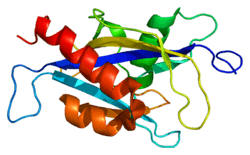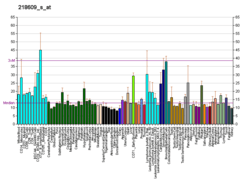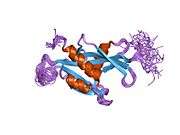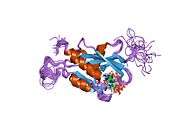NUDT2
Bis(5'-nucleosyl)-tetraphosphatase [asymmetrical] is an enzyme that in humans is encoded by the NUDT2 gene.[5][6][7]
This gene encodes a member of the MutT family of nucleotide pyrophosphatases, a subset of the larger NUDIX hydrolase family. The gene product possesses a modification of the MutT sequence motif found in certain nucleotide pyrophosphatases. The enzyme asymmetrically hydrolyzes Ap4A to yield AMP and ATP and is responsible for maintaining the intracellular level of the dinucleotide Ap4A, the function of which has yet to be established. This gene may be a candidate tumor suppressor gene. Alternative splicing has been observed at this locus and three transcript variants, all encoding the same protein, have been identified.[7]
References
- GRCh38: Ensembl release 89: ENSG00000164978 - Ensembl, May 2017
- GRCm38: Ensembl release 89: ENSMUSG00000028443 - Ensembl, May 2017
- "Human PubMed Reference:". National Center for Biotechnology Information, U.S. National Library of Medicine.
- "Mouse PubMed Reference:". National Center for Biotechnology Information, U.S. National Library of Medicine.
- Thorne NM, Hankin S, Wilkinson MC, Nunez C, Barraclough R, McLennan AG (Dec 1995). "Human diadenosine 5',5"'-P1,P4-tetraphosphate pyrophosphohydrolase is a member of the MutT family of nucleotide pyrophosphatases". Biochem J. 311 (3): 717–21. doi:10.1042/bj3110717. PMC 1136061. PMID 7487923.
- McLennan AG, Flannery AV, Morten JE, Ridanpaa M (Apr 1998). "Chromosomal localization of the human diadenosine 5',5"'-P1,P4-tetraphosphate pyrophosphohydrolase (Ap4A hydrolase) gene (APAH1) to 9p13". Genomics. 47 (2): 307–9. doi:10.1006/geno.1997.5092. PMID 9479504.
- "Entrez Gene: NUDT2 nudix (nucleoside diphosphate linked moiety X)-type motif 2".
Further reading
- Bessman MJ, Frick DN, O'Handley SF (1996). "The MutT proteins or "Nudix" hydrolases, a family of versatile, widely distributed, "housecleaning" enzymes". J. Biol. Chem. 271 (41): 25059–62. doi:10.1074/jbc.271.41.25059. PMID 8810257.
- Pinto RM, Costas MJ, Fernández A, et al. (1991). "Dinucleoside tetraphosphatase from human blood cells. Purification and characterization as a high specific activity enzyme recognized by an anti-rat tetraphosphatase antibody". FEBS Lett. 287 (1–2): 85–8. doi:10.1016/0014-5793(91)80021-T. PMID 1652465.
- Hankin S, Matthew N, Thorne H, McLennan AG (1995). "Diadenosine 5',5"'-P1,P4-tetraphosphate hydrolase is present in human erythrocytes, leukocytes and platelets". Int. J. Biochem. Cell Biol. 27 (2): 201–6. doi:10.1016/1357-2725(94)00076-N. PMID 7767787.
- Lazewska D, Starzyńska E, Guranowski A (1993). "Human placental (Asymmetrical) diadenosine 5',5-P1,P4-tetraphosphate hydrolase: purification to homogeneity and some properties". Protein Expr. Purif. 4 (1): 45–51. doi:10.1006/prep.1993.1007. PMID 8381042.
- Rotllán P, Rodríguez-Ferrer CR, Asensio AC, Oaknin S (1998). "Potent inhibition of specific diadenosine polyphosphate hydrolases by suramin". FEBS Lett. 429 (2): 143–6. doi:10.1016/S0014-5793(98)00579-1. PMID 9650578.
- Vartanian A, Alexandrov I, Prudowski I, et al. (1999). "Ap4A induces apoptosis in human cultured cells". FEBS Lett. 456 (1): 175–80. doi:10.1016/S0014-5793(99)00956-4. PMID 10452553.
- Guranowski A, Galbas M, Hartmann R, Justesen J (2000). "Selective degradation of 2'-adenylated diadenosine tri- and tetraphosphates, Ap(3)A and Ap(4)A, by two specific human dinucleoside polyphosphate hydrolases". Arch. Biochem. Biophys. 373 (1): 218–24. doi:10.1006/abbi.1999.1556. PMID 10620341.
- Abdelghany HM, Gasmi L, Cartwright JL, et al. (2002). "Cloning, characterisation and crystallisation of a diadenosine 5',5"'-P(1),P(4)-tetraphosphate pyrophosphohydrolase from Caenorhabditis elegans". Biochim. Biophys. Acta. 1550 (1): 27–36. doi:10.1016/S0167-4838(01)00263-1. PMID 11738085.
- Strausberg RL, Feingold EA, Grouse LH, et al. (2003). "Generation and initial analysis of more than 15,000 full-length human and mouse cDNA sequences". Proc. Natl. Acad. Sci. U.S.A. 99 (26): 16899–903. doi:10.1073/pnas.242603899. PMC 139241. PMID 12477932.
- Guranowski A, Sillero A, Günther Sillero MA (2003). "Selective splitting of 3'-adenylated dinucleoside polyphosphates by specific enzymes degrading dinucleoside polyphosphates". Acta Biochim. Pol. 50 (1): 123–30. PMID 12673352.
- Pitcher WH, Kirby TW, DeRose EF, London RE (2003). "Metabolic transformation of AZTp4A by Ap4A hydrolase regenerates AZT triphosphate". Antiviral Res. 58 (3): 227–33. doi:10.1016/S0166-3542(03)00003-2. PMID 12767470.
- Gerhard DS, Wagner L, Feingold EA, et al. (2004). "The status, quality, and expansion of the NIH full-length cDNA project: the Mammalian Gene Collection (MGC)". Genome Res. 14 (10B): 2121–7. doi:10.1101/gr.2596504. PMC 528928. PMID 15489334.
- Swarbrick JD, Buyya S, Gunawardana D, et al. (2005). "Structure and substrate-binding mechanism of human Ap4A hydrolase". J. Biol. Chem. 280 (9): 8471–81. doi:10.1074/jbc.M412318200. PMID 15596429.
- Swarbrick JD, Buyya S, Gunawardana D, et al. (2005). "1H, 13C, and 15N resonance assignments of the 17 kDa Ap4A hydrolase from Homo sapiens in the presence and absence of ATP". J. Biomol. NMR. 31 (2): 181–2. doi:10.1007/s10858-004-7440-4. PMID 15772762.
This article is issued from Wikipedia. The text is licensed under Creative Commons - Attribution - Sharealike. Additional terms may apply for the media files.








